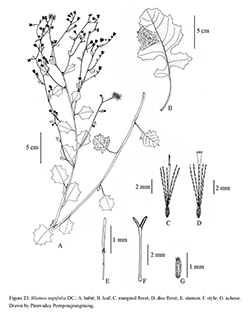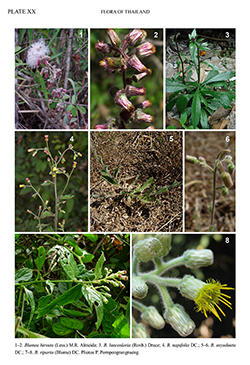e-Flora of Thailand
Volume 13 > Part 2 > Year 2016 > Page 218 > Compositae (Asteraceae) > Blumea
15. Blumea napifolia DC.wfo-0000131733
Prodr. 5: 440. 1836; Kerr, Fl. Siam. 2(3): 260. 1936; Randeria, Blumea 10: 269. 1960. Fig. 23; Plate XX: 4.
Accepted Name : This is currently accepted.
Synonyms & Citations :
Description : Annual herb, 0.1–1 m tall; stem erect, pubescent with pilose and glandular hairs. Leaves petiolate, blade oblanceolate or lacerate, 1–14 by 0.5–7 cm, apex round or acute, base attenuate or obtuse, margins serrate or lacerate, thinly papyraceous, bright green, both surfaces glabrate with glandular hairs; petioles 0.5–3 cm long. Inflorescences terminal and/or axillary, large, loose panicles, 10–25 cm long. Capitula 4–6 mm diam., peduncles 1–20 mm long with dense stipitate glands; involucres tubular-campanulate or campanulate; phyllaries green or reddish purple, 4–5-seriate, outer lanceolate with entire margins, 0.4–0.5 mm wide, pubescent with pilose and glandular hairs, apex acute, inner herbaceous with broad scarious margins, without stipitate glands; receptacle 1–3 mm diam., flat, alveolate, glabrous. Marginal floret corollas yellow, basal tube 2–3 mm long, lobes generally glabrous. Disc floret corollas yellow, basal tube 2.8–5 mm long, glabrous, lobes oblong-lanceolate, 0.5–0.6 mm long, glabrous with glandular hairs; anthers 0.9–1 mm long, apical appendages emarginate, bases with unbranched tails, anther-tails shorter than anther collars; style arms ca 1 mm long, base swollen. Achenes elliptic, 5-ribbed, 0.6–1 mm long, setuliferous; pappus bristles ca 10, 2.5–3 mm long, caducous, white.
Thailand : NORTHERN: Mae Hong Son (Mo Paeng Falls), Chiang Mai (Doi Suthep, Huai Kaeo Arboretum, Doi Chiang Dao, Fang Hot Spring Park, Huai Nam Dang, Doi Chang), Chiang Rai (Ban Nong Lu, Doi Tung, Wat Tham Saohin Phayanak, Mae Sai), Lampang (Mae Thak, Doi Khun Tan, Mae Tha distr.), Nan, Phrae (Mae Yom NP, Sahiap, Long), Tak (Rahaeng, Khao Phra Wo), Kamphaeng Phet; NORTH-EASTERN: Phetchabun (Huai Pong, Thung Salaeng Luang NP, Nam Nao NP, Bueng Samphan), Loei (Phu Kradueng, Si Than, Chiang Khan, Ban Na Ao), Nakhon Phanom (Phu Mu Forest Park, Nikhom Khamsoi), Khon Kaen (Phu Wiang); EASTERN: Nakhon Ratchasima (Khao Yai NP); SOUTH-WESTERN: Kanchanaburi (Thung Yai Naresuan, Lai Wo, Ban Sa-ne, Karen Village), Sangkhla, Singkhon Thapo, Sai Yok Yai Falls, Kroengkawia, Thong Phaphum to Pilok), Ratchaburi (Wangka); CENTRAL: Sing Buri, Phra Nakhon Si Ayutthaya, Krung Thep Maha Nakhon (Bangkok); SOUTH-EASTERN: Prachin Buri (Chakan Arboretum, Ban Mu Angkao), Chanthaburi (Khao Soi Dao, Makham), Trat (Ko Chang); PENINSULAR: Ranong (Khao Phota Luang Kaeo, Praphat beach, Lamliang), Surat Thani (Klong Saeng WS, Chiao Lan Reservoir, Ban Takum), Satun (Khuan Bo).
Distribution : China (Hainan), India, Bhutan, Nepal, Myanmar, Indochina, Malaysia (Peninsular), Indonesia (Java).
Ecology : A very common weed in rice fields and disturbed areas, deciduous forests with bamboo and in open dry areas of mixed evergreen forests, dry evergreen forests, from sea level to 1,700 m alt. Flowering: December–March.
Vernacular : Kameng hom (กะเม็งหอม)(Khon Kaen); phakkat na (ผักกาดนา)(Phra Nakhon Si Ayutthaya).


